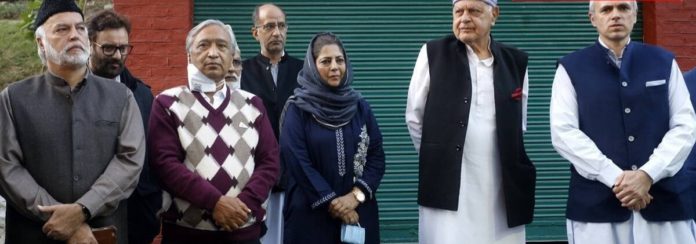The Centre on Saturday (October 17) amended the Jammu and Kashmir Panchayati Raj Act, 1989, to facilitate the setting up of District Development Councils (DDC), the members of which will be directly elected by voters in the Union Territory.
What are DDCs and how will they be represented?
The District Development Councils (DDCs) are set to become a new unit of governance in Jammu and Kashmir. A legislation to this effect was brought in by the Ministry of Home Affairs on October 16 through an amendment to the Jammu and Kashmir Panchayati Raj Act, 1989. This structure will include a DDC and a District Planning Committee (DPC).
The J&K administration has also amended the J&K Panchayati Raj Rules, 1996, to provide for establishment of elected District Development Councils in J&K.
This system effectively replaces the District Planning and Development Boards in all districts, and will prepare and approve district plans and capital expenditure. Their key feature, however, is that the DDCs will have elected representatives from each district. Their number has been specified at 14 elected members per district representing its rural areas, alongside the Members of Legislative Assembly chairpersons of all Block Development Councils within the district.
The term of the DDC will be five years, and the electoral process will allow for reservations for Scheduled Castes, Scheduled Tribes and women. The Additional District Development Commissioner (or the Additional DC) of the district shall be the Chief Executive Officer of the District Development Council.
The council, as stated in the Act, will hold at least four “general meetings” in a year, one in each quarter.
What will be the process here onward?
The 14 constituencies for electing representatives to the DDC will have to be delimited. These constituencies will be carved out of the rural areas of the district, and elected members will subsequently elect a chairperson and a vice-chairperson of the DDC from among themselves.
The notification for the election is likely to be issued within the next 10 days. Meanwhile, J&K is also preparing for by-polls to over 13,000 vacant panchayat seats in November.
Within the third tier, where do the DDCs fit in?
The DDCs replace the District Planning and Development Boards (DDBs) that were headed by a cabinet minister of the erstwhile state of Jammu and Kashmir. For Jammu and Srinagar districts, as winter and summer capitals, the DDBs were headed by the Chief Minister. However, for Leh and Kargil districts, the Autonomous Hill Development Councils performed the functions designated for the DDBs.
The Councils will oversee the functions of the Halqa Panchayats and the Block Development Councils in tandem with the line departments of the Union Territory.
For every district there will be District Planning Committee comprising Members of Parliament representing the area, Members of the State Legislature representing the areas within the District, chairperson of the District Development Council of the District, chairpersons of the town area committees/municipal committees of the district; president of the municipal council/municipal corporation, if any; the district development commissioner; additional district development commissioner, among others. The MP will function as the chairperson of this committee.
The committee will “consider and guide” the formulation of development programmes for the district, and indicate priorities for various schemes and consider issues relating to the speedy development and economic uplift of the district; function as a working group for formulation of periodic and annual plans for the district; and formulate and finalise the plan and non-plan budget for the district.
What was the earlier function of DDBs, and their composition?
The DDBs functioned as planning bodies, charting and formulating the district’s developmental plans. They functioned as working groups for the formulation of periodic and annual plans for the districts. All the funds provided by the government or any other agency, meant for the development of the district, would flow through the District Planning and Development Board as per the district plans.
The body used to meet once a year to deliberate and approve the district plans or oversee implementation of centrally sponsored schemes. Until 1998 the Deputy Commissioner of the district would head this committee, thereafter, elected members took charge of the body.
While the DDBs functioned under the chairmanship of a cabinet minister with MPS MLAs and MLC as members and the district’s Deputy Commissioner as its member secretary, the DDC will be headed by a chairman from among the elected representatives.
The scope of the functions of the DDCs have been amplified by the addition of the planning process being handed over directly to the elected representatives. Earlier, the DCs would prepare plans, and the DDBs would meet to approve them or make changes.
However, under this new system, with the Halqa Panchayat as the basic unit, the district’s yearly and five-yearly development plans will be finalised by a three-tier system of gram panchayats, Block Development Councils, and District Development Councils. The DDCs will receive plans from Block Development Councils and, after scrutiny, send them “for adherence to the Government guidelines, norms and rules” and submit the consolidated plan to the District Planning Committee.
Additionally the DDCs will form five standing committees, for Finance, Development, Public Works, Health And Education And Welfare.
What is the Centre’s objective behind this new structure?
The J&K administration in a statement said that the move to have an elected third tier of the Panchayati Raj institution marks the implementation of the entire 73rd Amendment Act in J&K. The idea is that systems that had been made defunct by earlier J&K governments such as the panchayati raj system are being revived under the Centre’s rule in the state through the Lieutenant Governor’s administration.
In the absence of elected representatives in the UT, senior government officials argue that DDCs will effectively become representative bodies for development at the grassroots in the 20 districts of the UT. They hope that this may draw some former legislators in as well.


